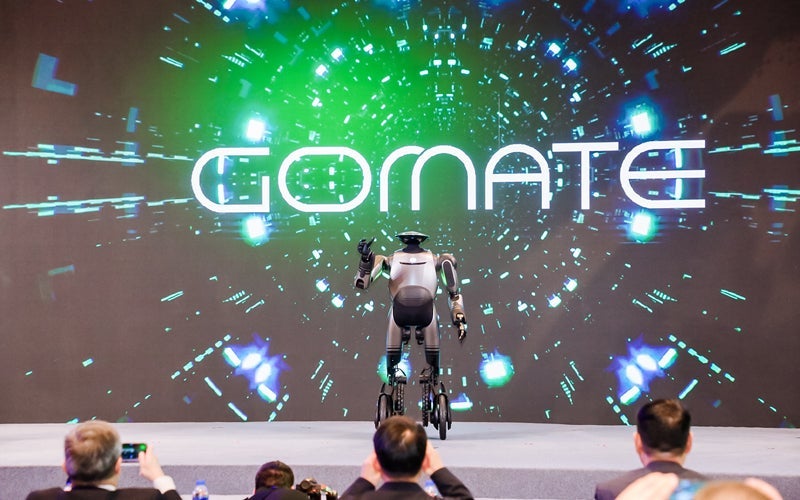
As the competition in China’s electric vehicle (EV) market settles, with a few key players emerging victorious to dominate the field, major Chinese EV companies are venturing into humanoid robotics. This shift is driven not only by financial need but also by the advantages these companies already hold in this new field, including robust supply chains and years of experience in developing advanced technology.
GAC’s GoMate can operate in both two-wheel and four-wheel mode
In December 2024, Chinese automotive manufacturer Guangzhou Automobile Group (GAC) unveiled the third generation of its humanoid robot, the GoMate. Although GAC has stated it will not be deployed for car manufacturing until 2026, this unveiling represents a step forward for autonomous humanoid robots. This robot is designed to operate in different environments with its variable wheel mobility structure, supporting both four- and two-wheel modes.
In four-wheel mode, the robot stands approximately 1.4m tall and can navigate stairs, overcome obstacles, and climb slopes. Switching to the two-wheel mode increases its height to 1.75m, enhancing flexibility and reducing its spatial footprint. Powered by GAC’s self-developed autonomous driving algorithm, the GoMate can move effectively in dynamic environments. The robot can detect obstacles within a 100m range, ensuring safety in hectic environments.
Integrating advanced technologies, such as the multi-modal AI sensing system, enables the GoMate to process various sensory inputs in real-time, making it suitable for high-demand environments requiring precision, efficiency, and adaptability. The robot’s hand can perform intricate tasks, enhancing its versatility, while its lightweight and compact design allows it to operate in confined spaces.
The GoMate aims to address industry challenges related to operational efficiency, safety, and automation in complex environments. Introducing these robots to the workplace to work alongside specialized human workers should improve productivity.

US Tariffs are shifting - will you react or anticipate?
Don’t let policy changes catch you off guard. Stay proactive with real-time data and expert analysis.
By GlobalDataRobotics in Automotive – Thematic Intelligence
XPeng’s Iron has 200 degrees of freedom
Another leading Chinese EV manufacturer, XPeng, has introduced its first humanoid robot, Iron. Standing 1.72m tall and weighing 70kg, the robot features 60 joints and 200 degrees of freedom – the number of independent movements a robot can make – enabling it to replicate human-like movement.
Iron is now working on the production lines at XPeng’s factory, helping assemble the company’s upcoming EV, the P7+. Powered by the same AI technology used in XPeng’s autonomous vehicles (AVs), Iron can move autonomously, replicate human postures like standing, sitting, or lying down, and accurately execute manual tasks. With 15 degrees of freedom in its hands, Iron can manipulate objects with the dexterity required for intricate industrial tasks.
XPeng’s Eagle Vision system and Turing 40-core AI chip provide Iron with advanced reasoning capabilities, allowing it to adapt to various scenarios. Similarly to GAC’s GoMate, XPeng’s Iron will not be limited to the automaking sphere, with the company ultimately intending to deploy it in offices, retail stores, and homes.
Nio partners with robot maker UBTech
Nio has been testing humanoid robots on the assembly line at one of its factories and is also forming an R&D team to enable it to develop its own version of the technology in-house. UBTech’s Walker S robot has been used for training purposes at Nio’s F1 and F2 manufacturing plants in China. According to UBTech, this was the first time its Walker S robot had undertaken real-world training at a new energy vehicle (NEV) factory.
While in operation, the Walker S performed quality inspections of door locks, seat belts, and headlight covers, and was also able to affix vehicle logos.
China is attempting to steal a march on the rest of the world in robotics and automation, similar to how it moved quickly to dominate the EV landscape. The Chinese government has promoted automation through its Robotics+ initiative, which aims to double the country’s manufacturing robot density by 2025, compared with 2020 levels.
Wang Xingxing, the CEO of Unitree Robots, said in a recent interview that “robotics is where EVs were a decade ago – a trillion-yuan battlefield waiting to be claimed.” The actions of the Chinese government and its leading automakers certainly suggest that they share this view.








